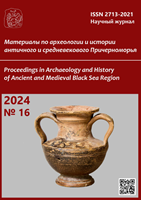Перстень-печать с надписью «Muhammad» из средневекового городища Джанкент
Signet ring with an inscription “Muhammad” from the medieval settlement of Jankent
Author(s): Rustem Darmenov, Bakyt KhassenovaSubject(s): Archaeology, Cultural history, Social history, History of Islam, History of Religion
Published by: Нижневартовский государственный университет
Keywords: toreutics; Aral Sea region; Jankent; Ancient Turkic; Oghuz; Islam;
Summary/Abstract: The article presents the materials of “Islamic world”, obtained during archaeological works on the settlement of Jankent that are introduced into the scientific circulation for the first time. In 7th — 9th cc., Central Asia and Kazakhstan were faced with the Arab conquests, as a result of which the Muslim states with the local Islamized aristocracy were appeared. The medieval historical sources describe that the Muslims and Turks inhabited the cities along the Silk Road, where the power belonged to the Turkic rulers. The settlement of Jankent is one of the well-studied medieval settlements in the eastern part of the Aral Sea region, which is considered as the capital of the Oghuz State. The archaeological study provided a new perspective on the relationship between the Oghuz Turks and the Arab Caliphate. The archaeological and numismatic materials testify that there was an establishment of trade between the centers of the Arab caliphate and the peoples living in the territory of the steppe of Eurasia. The Jankent ring not only shows the economic and political position of South Kazakhstan in the 8th — 9th — 10th cc., but it also documents precisely the change of epoch, styles, culture and tastes of the Turkic tribes during the reign of the Arab Caliphate on the Eurasian continent.
Journal: Материалы по археологии и истории античного и средневекового Причерноморья
- Issue Year: 2024
- Issue No: 16
- Page Range: 512-526
- Page Count: 15
- Language: Russian

